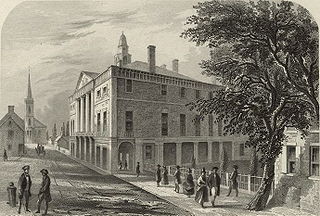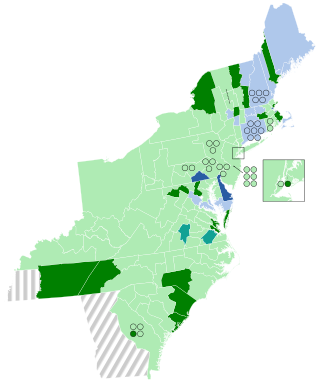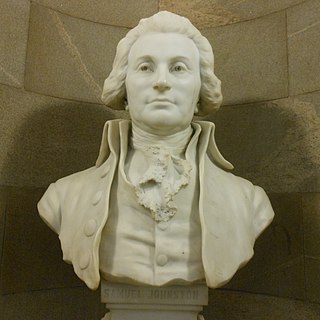| |||||||||||||||||||
All 8 Pennsylvania seats to the United States House of Representatives | |||||||||||||||||||
|---|---|---|---|---|---|---|---|---|---|---|---|---|---|---|---|---|---|---|---|
| |||||||||||||||||||
An election to the United States House of Representatives was held in Pennsylvania on November 26, 1788, for the 1st Congress.
| ||||||||||||||||
All 8 Pennsylvania seats to the United States House of Representatives | ||||||||||||||||
|---|---|---|---|---|---|---|---|---|---|---|---|---|---|---|---|---|
| ||||||||||||||||
| Elections in Pennsylvania |
|---|
 |
An election to the United States House of Representatives was held in Pennsylvania on November 26, 1788, for the 1st Congress.
The United States Constitution was adopted on September 17, 1787, by the Constitutional Convention in Philadelphia, and then ratified by the States. Pennsylvania's legislature ratified the Constitution on December 12, 1787, by a vote of 46-23. On July 8, 1788, the Congress of the Confederation passed a resolution calling the first session of the 1st United States Congress for March 4, 1789, to convene at New York City and the election of senators and representatives in the meanwhile by the States.
Pennsylvania's legislature scheduled the election for November 26, 1788, and provided for the election to be held on an at-large basis, an attempt by the Federalist-dominated legislature to prevent anti-Federalist Representatives from being elected in frontier districts. Both parties submitted tickets with 8 candidates each. The large German population in Pennsylvania tended to vote for German candidates, giving the Anti-Federalist Muhlenberg and Hiester enough votes to gain seats. [1]
| Pro-Administration | Anti-Administration | ||||
|---|---|---|---|---|---|
| Frederick Muhlenberg | 8,707 | 7.49% | Peter Muhlenberg | 7,417 | 6.38% |
| Henry Wynkoop | 8,246 | 7.09% | Daniel Hiester | 7,403 | 6.37% |
| Thomas Hartley | 8,163 | 7.02% | William Findley | 6,586 | 5.66% |
| George Clymer | 8,094 | 6.96% | William Irvine | 6,492 | 5.58% |
| Thomas Fitzsimons | 8,086 | 6.95% | Charles Pettit | 6,481 | 5.57% |
| Thomas Scott | 8,068 | 6.94% | William Montgomery | 6,348 | 5.46% |
| John Allison | 7,067 | 6.08% | Blair McClenachan | 6,223 | 5.35% |
| Stephen Chambers | 7,050 | 6.06% | Robert Whitehall | 5,850 | 5.03% |

The 1788–1789 United States presidential election was the first quadrennial presidential election. It was held from Monday, December 15, 1788, to Saturday, January 10, 1789, under the new Constitution ratified that same year. George Washington was unanimously elected for the first of his two terms as president and John Adams became the first vice president. This was the only U.S. presidential election that spanned two calendar years without a contingent election and the first national presidential election in American history.

The 1st United States Congress, comprising the United States Senate and the United States House of Representatives, met from March 4, 1789, to March 4, 1791, during the first two years of George Washington's presidency, first at Federal Hall in New York City and later at Congress Hall in Philadelphia. With the initial meeting of the First Congress, the United States federal government officially began operations under the new frame of government established by the 1787 Constitution. The apportionment of seats in the House of Representatives was based on the provisions of Article I, Section 2, Clause 3 of the Constitution. Both chambers had a Pro-Administration majority. Twelve articles of amendment to the Constitution were passed by this Congress and sent to the states for ratification; the ten ratified as additions to the Constitution on December 15, 1791, are collectively known as the Bill of Rights, with an additional amendment ratified more than two centuries later to become the Twenty-seventh Amendment to the United States Constitution.

The 1822–23 United States House of Representatives elections were held at various dates in different states between July 1822 and August 1823 during President James Monroe's second term.
The 1816–17 United States House of Representatives elections were held at various dates in different states between April 1816 and August 1817.

The 1812–13 United States House of Representatives elections were held at various dates in different states between April 1812 and August 1813 as James Madison was re-elected president.
The 1808–09 United States House of Representatives elections were held at various dates in different states between April 1808 and May 1809 as James Madison was elected president.

The 1804–05 United States House of Representatives elections were held at various dates in each state between April 24, 1804 and August 5, 1805. The Congress first met on December 2, 1805. The elections occurred at the same time as President Thomas Jefferson's re-election.

The 1802–03 United States House of Representatives elections were held at various dates in each state, from April 26, 1802 to December 14, 1803 during President Thomas Jefferson's first term in office. It was common in the early years of the United Congress for some states to elect representatives to a Congress after it had already convened. In the case of the 8th Congress, the representatives from New Jersey were only elected after its first meeting on October 17, 1803.

The 1796–97 United States House of Representatives elections took place in the various states took place between August 12, 1796, and October 15, 1797. The first session was convened on May 15, 1797, at the proclamation of the new President of the United States, John Adams. Since Kentucky and Tennessee had not yet voted, they were unrepresented until the second session.

The 1792–93 United States House of Representatives elections coincided with the re-election of President George Washington. While Washington ran for president as an independent, his followers formed the nation's first organized political party, the Federalist Party, whose members and sympathizers are identified as pro-Administration on this page. In response, followers of Thomas Jefferson and James Madison created the opposition Democratic-Republican Party, who are identified as anti-Administration on this page. The Federalists promoted urbanization, industrialization, mercantilism, centralized government, and a broad interpretation of the United States Constitution. In contrast, Democratic-Republicans supported the ideal of an agrarian republic made up of self-sufficient farmers and small, localized governments with limited power.

The 1790–91 United States House of Representatives elections, took place in the middle of President George Washington's first term. While formal political parties still did not exist, coalitions of pro-Washington (pro-Administration) representatives and anti-Administration representatives each gained two seats as a result of the addition of new states to the union.

The 1788–89 United States House of Representatives elections, coincided with the election of George Washington as first the president of the United States. The dates and methods of election were set by the states. Actual political parties did not yet exist, but new members of Congress were informally categorized as either "pro-Administration" or "anti-Administration".

The drafting of the Constitution of the United States began on May 25, 1787, when the Constitutional Convention met for the first time with a quorum at the Pennsylvania State House in Philadelphia, Pennsylvania to revise the Articles of Confederation. It ended on September 17, 1787, the day the Frame of Government drafted by the convention's delegates to replace the Articles was adopted and signed. The ratification process for the Constitution began that day, and ended when the final state, Rhode Island, ratified it on May 29, 1790.

The Congressional Apportionment Amendment is a proposed amendment to the United States Constitution that addresses the number of seats in the House of Representatives. It was proposed by Congress on September 25, 1789, but was never ratified by the requisite number of state legislatures. As Congress did not set a time limit for its ratification, the Congressional Apportionment Amendment is still pending before the states. As of 2022, it is one of six unratified amendments.
The 1789 United States Senate election in New York was held in July 1789 to elect two U.S. Senators to represent the State of New York in the United States Senate. It was the first such election, and before the actual election the New York State Legislature had to establish the proceedings how to elect the senators.
The 1794–95 United States Senate elections were elections that had the formation of organized political parties in the United States, with the Federalist Party emerging from the Pro Administration coalition, and the Democratic-Republican Party emerging from the Anti-Administration coalition.

The 1789 United States House of Representatives elections in New York were held on March 3 and 4, 1789, to elect 6 U.S. Representatives to represent the State of New York in the 1st United States Congress.

The 1788–89 United States Senate elections were the first elections for the United States Senate, which coincided with the election of President George Washington. As of this election, formal organized political parties had yet to form in the United States, but two political factions were present: The coalition of senators who supported George Washington's administration were known as "Pro-Administration", and the senators against him as "Anti-Administration".

The United States elections of 1788–1789 were the first federal elections in the United States following the ratification of the United States Constitution in 1788. In the elections, George Washington was elected as the first president and the members of the 1st United States Congress were selected.

The Fayetteville Convention was a meeting by 271 delegates from North Carolina to ratify the US Constitution. Governor Samuel Johnston presided over the convention, which met in Fayetteville, North Carolina, from November 16 to 23, 1789 to debate on and decide on the ratification of the Constitution, which had recommended to the states by the Philadelphia Convention during the summer of 1787. The delegates ratified the Constitution by a vote of 194 to 77, thus making North Carolina the 12th state to ratify the constitution.